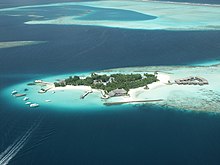Fishing industry in the Maldives

|
|
| General characteristics | |
|---|---|
| Coastline | 640 km (400 mi) |
| EEZ area | 923,000 km2 (356,000 sq mi) |
| EEZ PP | 387 mg or 5.97 gr C/m²/day |
| Shelf area | 35,000 km2 (14,000 sq mi) |
| Land area | 300 km2 (120 sq mi) |
| Employment | Full-time: 22,000 (1996) Part-time: 5,000 (1996) |
| Fishing fleet | 1,674 vessels, nearly all motorised (1995) |
| Export value | US$ 56 million (1997) |
| Import value | nil |
| Harvest | |
| Wild marine | 184,158 tonnes (202,999 tons) (2006) |
| Aquaculture total | nil |
|
|
|
|
|
|
|
|
|
|
|
|
|
|
The fishing industry in the Maldives is the island's second main industry. According to national tradition in the words of former President Maumoon Abdul Gayoom, "Fishing is the lifeblood of our nation, it is inborn. From the soil on which we live, to the sea around us, it remains an integral part of our existence. Fishing, and our country and its people, [are] one and shall remain inseparable forever." The Maldives has an abundance of aquatic life and species of fish. Common are tuna, groupers, dolphin fish, barracuda, rainbow runner, trevally and squirrelfish and many more. Aside from being of essential importance to the economy, fishing is also a popular recreational activity in the Maldives, not only among locals but by tourists. The islands have numerous fishing resorts which cater for these activities.
The Maldives is an archipelago in the Indian Ocean, located south west of the southern tip of India. Its population in 2008 was 386,000. There are twenty-six atolls containing 1,192 islets, of which two hundred and fifty islands are inhabited. The low level of islands makes them vulnerable to sea level rises.
Fishing has long been the life blood of the Maldivian economy. Today it still employs half the Maldivian workforce. Formerly, Maldives shipped 90 percent of its fishing catch of tuna in dried form to Sri Lanka. However, because Sri Lanka cut back its imports of such fish, in 1979 Maldives joined with the Japanese Marubeni Corporation to form the Maldives Nippon Corporation that canned and processed fresh fish. Also in 1979 the Maldivian government created the Maldives Industrial Fisheries Company. This company controls the processing and exporting of frozen and canned tuna. They also provide a collector vessel. All fishing is undertaken by the private sector and its involvement in processing and export is increasing.
...
Wikipedia
